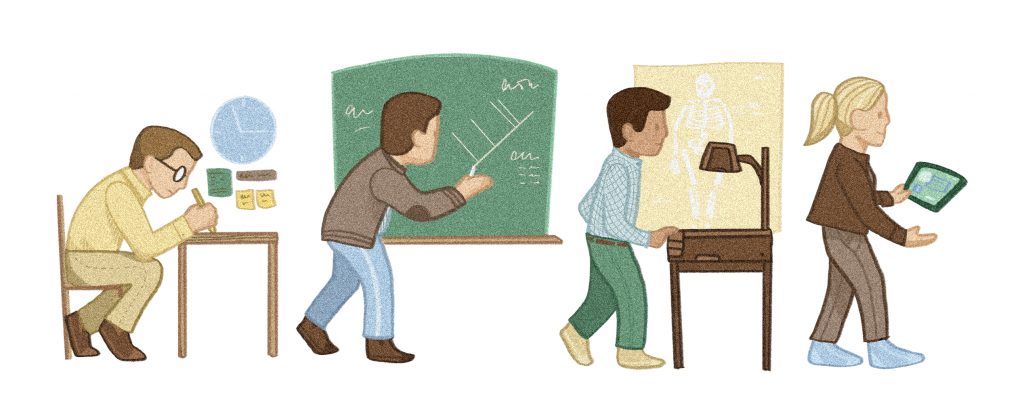In recent decades, education has undergone a significant transformation due to technological advancements and evolving teaching methods. Traditional classrooms are gradually being replaced by digital learning environments, incorporating a wide range of technological tools and online platforms. This shift has redefined how students learn and created fresh challenges and opportunities for educators.
Similarly, teachers have evolved from knowledge providers to facilitators, mentors, and curators of learning experiences.
Ahead of Teachers’ Day, here’s what a few teachers have to share with Sunday POST on the transition and the role of teachers in the process.
‘Transition into digital
format wasn’t seamless’
Shaheen Akhtar, PGT English in Kendriya Vidyalaya of Deogarh, says, “I’ve been an educator for approximately 3 years, and I believe the phase of change was fairly demanding. While newer teachers are familiar with modern tools, their more experienced counterparts are not as comfortable. They tend to struggle in adapting to new processes and are not very comfortable with technology.”
Sharing her experience she adds, “I’ve worked as an educator since the start of the pandemic. Throughout that period, educational institutions predominantly adopted online platforms like Zoom and Google Meet as it was the need of that period. However, my transition into this digital format wasn’t entirely seamless. I’ve experienced teaching in both online and offline settings and observed a significant transformation. The dynamics of student-teacher engagement have shifted. While face-to-face interactions were possible in offline classes, fostering engagement in virtual settings has proven to be challenging and draining.”
Therefore, Akhtar is for traditional in-person teaching instead of online classes.
“Because the process of establishing online connections and enrolling students in digital platforms takes nearly 15 minutes, which ends up consuming the entire teaching duration. In a traditional classroom setup, we have more teaching time available and can utilise it fully without any time wastage,” she points out.
“In online classes, students often lack full focus, opting to deactivate their camera and microphone to engage in other activities. On the other hand, in traditional classes, this isn’t possible, and the in-person presence of students significantly enhances the learning process compared to the online setting,” says Shaheen putting emphasis on how the students’ engagement is important for their growth.
‘Embracing new educational
technologies is essential’
Esther Ghanta Rout, a teaching faculty at Stewart School, Cuttack, says she has a desire to spread positivity wherever she teaches. She also has a genuine fondness for being in the company of children.
Talking about the change in teaching mode, Rout says, “The rise of digital learning has enabled adaptable teaching techniques. Utilising audio-visual aids enhances students’ grasp and memory retention compared to traditional teaching.”
She adds by saying, “The advent of digital learning technologies introduces captivating and immersive educational encounters, amplifying student involvement. Merging multimedia resources, real-time collaboration, and interactive assessments garners student interest, fostering active engagement. This tech-driven transformation makes learning more vibrant and accessible, facilitating customised and varied learning exploits.”
Batting for the changes, she further says, “For educators, ongoing learning and adapting to changes are vital to improve teaching methods. Embracing new educational technologies is essential due to the variety of available platforms. Yet, shifting from in-person to digital learning results in a challenge, the loss of meaningful teacher-student connections. Traditional face-to-face learning enables direct communication, unlike digital learning, potentially causing delays in issue resolution.”
Listing other benefits, she concludes, “The shift from traditional in-person education to online learning due to the Covid-19 pandemic has been particularly impactful in remote areas and among those less familiar with technology. This change has transformed education, using digital platforms for teaching and sharing knowledge. A clear difference arises in how students engage: conventional methods lean toward passive listening and memorization, while digital learning promotes active participation and peer cooperation.”
‘Training more important than technology’
Deepak Ranjan Padhi, Asst. Professor, NIFT BBSR, commenting the challenges of online education says, “The research paper I presented at India HCI 2020 and international conference explored challenges faced by educators during online teaching. Switching from traditional chalkboard methods to e-learning during the pandemic was tough. Online tools like Zoom, Google Talk, and Skype were challenging to navigate, designed more for meetings than teaching. Despite features like Zoom’s Scribble boards aiding classroom interactions, educators struggled due to limited training. Schools conducted exams online, using methods like photographing handwritten answers via WhatsApp, limiting evaluation quality. Crafting online questionnaires posed another challenge.”
Pointing out other hurdles, he adds, “Despite Odisha’s 5T schools initiative, technology’s education potential remained untapped. Teacher training was insufficient and generating appealing digital content, like PowerPoint presentations too was difficult. Training, practice, and evaluation were needed. Online learning also hindered group activities and meaningful interactions. ”
Training is more important than technology, observed Padhi.
Underscoring its need, he continues: “It became evident that teachers’ skill enhancement was more crucial than the technology itself. While the shift to online education brought up concerns of decreased attention spans and student engagement due to the freedom granted by virtual platforms, the effectiveness of content delivery was already a concern in physical classrooms.”
Asked what the teachers need to do in present scenario, he suggests, “Now, educators must revamp their teaching strategies, be creative with content, and identify what captures students’ attention.”
In the present scenario, educators must revamp their teaching strategies, be creative with content, and identify what captures students’ attention, says Deepak Ranjan Padhi, an assistant professor at NIFT, Bhubaneswar
MADHUMSITA SAHU, OP
